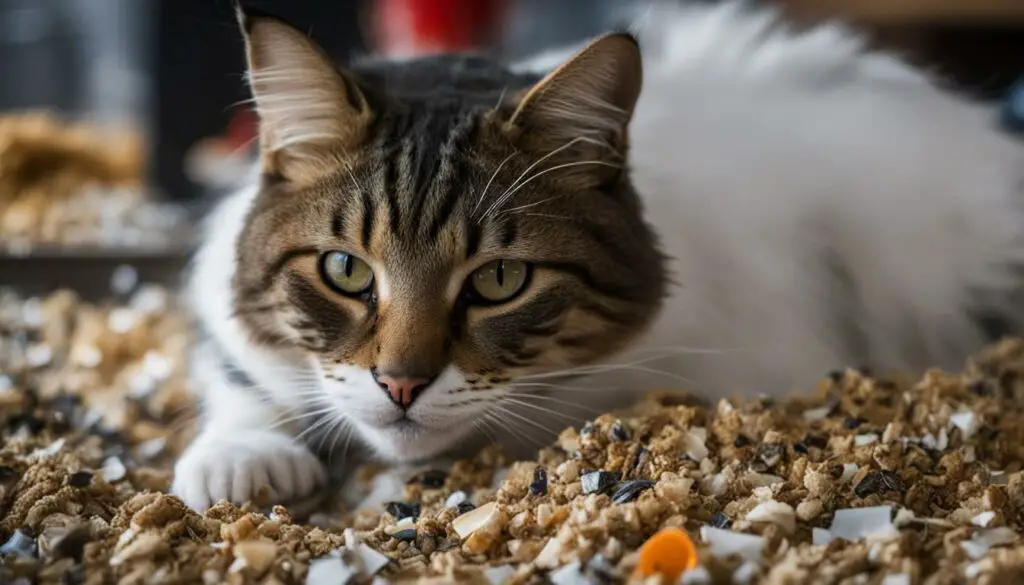Is your cat displaying the unusual behavior of sleeping in its litter box? If so, you may be wondering why this is happening and what you can do to address it. In this article, I will explore the possible reasons behind this behavior and provide insights on how to ensure your cat’s well-being.
Key Takeaways:
- Cats may sleep in their litter box due to medical or behavioral reasons.
- Common medical reasons include arthritis, cognitive dysfunction, and certain illnesses.
- Stress or anxiety can also lead to cats choosing the litter box as a sleeping spot.
- Sleeping in the litter box can pose health risks such as infections and digestive tract blockages.
- Consulting with a veterinarian is crucial to rule out medical issues and seek appropriate guidance.
Medical Reasons for Sleeping in the Litter Box
When a cat starts sleeping in its litter box, it’s important to consider the possibility of underlying medical issues. Cats can exhibit this behavior due to various reasons, including arthritis, cognitive dysfunction, and certain illnesses such as urinary tract infections and diabetes. Older cats may find it easier to access the litter box due to joint pain, while cognitive decline can cause confusion about toileting and resting areas.
Arthritis is a common condition that affects cats as they age. Joint pain can make it difficult for them to comfortably access their usual resting spots, leading them to choose the litter box as an alternative. Cognitive dysfunction, which is similar to Alzheimer’s disease in humans, can cause confusion and disorientation. Cats with cognitive dysfunction may forget where their usual resting spots are, leading them to seek comfort in the litter box.
In addition, certain medical conditions such as urinary tract infections and diabetes can increase a cat’s need to urinate more frequently, causing them to spend more time in the litter box. It’s essential to address these medical issues promptly to ensure the well-being and comfort of your cat.

While medical reasons should be ruled out first, it’s important to keep in mind that cats may also sleep in their litter box due to behavioral factors. In the next section, we will explore the behavioral reasons behind this behavior and discuss strategies to address it.
Behavioral Reasons for Sleeping in the Litter Box
While medical issues can be a common cause of cats sleeping in their litter boxes, behavioral factors also play a significant role. Cats are known for being creatures of habit, and any changes or disruptions to their environment can cause stress and anxiety. This can lead them to seek comfort and security in familiar spaces, such as their litter box.
Stressors like moving to a new home, the addition of new pets or family members, or loud noises can all trigger this behavior. Cats may view the litter box as a safe haven where they can retreat and feel protected. Sleeping in the litter box allows them to stay close to their scent, which can provide a sense of comfort and familiarity.
Additionally, cats are naturally clean animals, and they may choose to sleep in their litter box if they feel that their sleeping areas are not clean enough. This behavior is their way of seeking a clean and hygienic space to rest. If your cat is sleeping in the litter box, it is essential to evaluate their environment and address any sources of stress or discomfort to encourage more appropriate sleeping behaviors.
Creating a Calm Environment
To discourage your cat from sleeping in the litter box, make sure that there are other comfortable and inviting resting areas available for them. Provide cozy beds, blankets, or cat trees in quiet and peaceful locations throughout your home. These alternative sleeping spots should be in areas where your cat feels safe and secure.
Creating a calm environment can help reduce stress and anxiety. Minimize disruptions and introduce any changes gradually. Use pheromone sprays or diffusers to create a soothing atmosphere. By addressing their behavioral needs and providing a calm and comfortable environment, you can help redirect your cat’s sleeping habits away from the litter box.
Potential Risks and Health Issues
Sleeping in the litter box can have negative implications for your cat’s health. It is important to understand the potential risks associated with this behavior and take appropriate action to mitigate them.
The following table summarizes the possible health issues that can arise from sleeping in the litter box:
| Health Issues | Description |
|---|---|
| Bacterial Infections | Sleeping in a litter box increases the likelihood of bacterial infections in the eyes, ears, and bladder. Cats may come into contact with contaminated litter, leading to infections. |
| Skin Infections | If litter gets stuck in your cat’s fur while they sleep in the litter box, it can lead to skin infections. The constant contact with dirty litter can irritate and inflame the skin. |
| Digestive Tract Issues | Ingesting litter can be harmful to your cat’s digestive tract. If they consume a substantial amount of litter, it can cause blockages and hinder their ability to pass stool. |
These potential health issues emphasize the importance of addressing the behavior of sleeping in the litter box promptly. By taking steps to discourage this habit, you can help ensure the well-being and overall health of your cat.
Seeking Veterinary Advice
If you notice that your cat is sleeping in the litter box, it is important to seek veterinary advice to ensure their well-being. A veterinarian can conduct a thorough examination to rule out any underlying medical conditions that may be causing this behavior. They can also provide guidance on addressing the behavior and recommend environmental changes or behavioral interventions to help your cat feel more secure and comfortable.

Consulting with a veterinarian is crucial because sleeping in the litter box can be a sign of an underlying medical issue or a reaction to stress and anxiety. The veterinarian will be able to determine the cause and develop an appropriate treatment plan. They may also suggest diagnostic tests, such as bloodwork or urinalysis, to further investigate any potential health issues.
Furthermore, a veterinarian can provide valuable insights into your cat’s behavior and offer advice on creating a stress-free environment. They can recommend changes to your cat’s living space, provide tips for reducing stressors, and suggest behavioral modifications that can help redirect your cat’s sleeping habits away from the litter box.
In conclusion, if your cat is sleeping in the litter box, do not hesitate to consult with a veterinarian. They have the expertise to identify any underlying medical conditions and provide the necessary guidance and support to address the behavior. Remember, seeking veterinary advice is the best way to ensure the health and well-being of your feline companion.
Addressing Medical Issues
If your cat is sleeping in the litter box, it is important to address any underlying medical issues that may be contributing to this behavior. A thorough examination by a veterinarian can help identify and treat any potential health problems. Here are some common medical issues that could cause your cat to sleep in the litter box:
- Arthritis: Cats with arthritis may find it difficult to access their regular resting areas, leading them to seek out the litter box as a more accessible option. Pain management medication and providing a litter box with lower sides can help address this issue.
- Cognitive dysfunction: Older cats may experience cognitive decline, which can result in confusion about toileting and resting areas. Supplements and environmental enrichment can support cognitive function and reduce confusion.
- Urinary tract infections and diabetes: Certain illnesses, such as urinary tract infections and diabetes, can cause increased urination and discomfort, making cats more likely to sleep in the litter box. Treatment for these conditions should be provided by a veterinarian.

“Addressing medical issues is crucial when it comes to cats sleeping in the litter box. It’s essential to consult with a veterinarian to determine the underlying cause and develop a treatment plan tailored to your cat’s specific needs.”
By addressing these medical issues, you can help your cat find relief and encourage them to use appropriate resting areas instead of the litter box. Consult with your veterinarian for guidance and treatment options specific to your cat’s condition.
Addressing Behavioral Issues
If stress or anxiety is determined to be the underlying cause of your cat sleeping in the litter box, it is important to take steps to address these issues. Creating a safe and stress-free environment for your cat is crucial in helping them find alternative resting places. Consider implementing the following strategies:
1. Provide Additional Hiding Places
Cats often seek out hiding spots when they feel stressed or anxious. By providing additional hiding places throughout your home, such as cat condos, shelves, or cardboard boxes, you can offer your cat more options for finding comfort and security.
2. Create a Calming Environment
Reducing environmental stressors can greatly help your cat feel more at ease. Avoid loud noises, keep a consistent routine, and provide a quiet and peaceful space for your cat to retreat to. You can also use pheromone sprays or diffusers that mimic the natural calming scents produced by cats to help create a soothing atmosphere.
3. Work with a Certified Cat Behavior Consultant
If your cat’s litter box sleeping behavior persists despite your efforts, consulting with a certified cat behavior consultant can provide valuable insights and guidance. A behavior consultant can help determine the underlying causes of your cat’s stress or anxiety and develop a customized plan to address the behavior effectively.
| Benefits of Addressing Behavioral Issues | Risks of Ignoring the Behavior |
|---|---|
|
|
“Creating a safe and stress-free environment for your cat is crucial in helping them find alternative resting places.”
By addressing the behavioral issues that may be causing your cat to sleep in the litter box, you can help them feel more secure and comfortable in their surroundings. Remember to be patient and consistent in implementing these strategies, as it may take time for your cat to adjust. Seeking professional advice when needed can also provide valuable support in resolving the behavior and ensuring your cat’s overall well-being.
Providing Comfortable Sleeping Options
Cats are creatures of comfort, and providing them with cozy and inviting sleeping options is essential in redirecting their sleeping habits away from the litter box. By offering a variety of beds and blankets, you can create alternative resting places that cater to their preferences and needs.
Consider the specific needs of your cat when selecting sleeping options. For older cats with joint pain or mobility issues, memory foam beds or beds with lower sides for easier access can provide the necessary comfort and support. Cubby-style beds can offer a sense of security for cats who prefer enclosed spaces.
It’s important to ensure that your cat’s sleeping areas are easily accessible and located in quiet, calm parts of your home. By providing comfortable and inviting resting places, you can help your cat feel safe and secure outside of the litter box.

Creating a Cat-Friendly Environment
In addition to comfortable sleeping options, creating a stress-free environment plays a crucial role in addressing your cat’s litter box sleeping behavior. Minimize disruptions and provide hiding spaces where your cat can retreat to when they need a quiet moment. This can be in the form of cozy cat caves, elevated perches, or dedicated hiding spots.
Consider using pheromone sprays or diffusers, as they can help create a calming atmosphere for your cat. These products release synthetic pheromones that mimic the natural facial pheromones cats use to mark their territory, helping to reduce stress and anxiety.
Establishing a consistent routine and introducing changes gradually can also alleviate stress. Cats are creatures of habit, and sudden changes to their environment can disrupt their sense of security. By implementing these strategies, you can create a cat-friendly environment that encourages restful sleep outside of the litter box.
Redirecting Sleeping Habits
Redirecting your cat’s sleeping habits away from the litter box may take time and patience. However, with consistent effort, it is possible to encourage your cat to choose alternative sleeping spots.
One effective strategy is to provide cozy beds in different locations around your home. Cats are naturally curious, and by offering a variety of comfortable options, you increase the likelihood of them exploring and choosing a bed that suits their preferences.
Additionally, you can use catnip or pheromone sprays to attract your cat to their new sleeping areas. These scents can pique their interest and entice them to try out the new beds. Ensuring that their preferred sleeping spots are easily accessible further encourages them to choose these locations over the litter box.
Creating a Stress-Free Environment
If your cat is sleeping in the litter box, it is a clear indication of stress and anxiety. To ensure your cat’s well-being, it is crucial to create a calm and peaceful environment that promotes relaxation. By implementing a few simple strategies, you can help reduce your cat’s stress levels and discourage them from using the litter box as a resting place.
1. Minimize disruptions: Cats thrive in a stable and predictable environment. Avoid making sudden changes or introducing new elements that may cause stress. Stick to a consistent routine and gradually introduce any changes to your cat’s living space.
2. Provide hiding places: Cats are natural hide-and-seekers and enjoy having safe and secluded spots to retreat to when they feel overwhelmed. Consider creating hiding places such as cat trees, boxes, or cozy nooks where your cat can find solace.
3. Use pheromone sprays or diffusers: Pheromones are natural chemicals that cats release to communicate with each other. Synthetic versions of these pheromones are available in the form of sprays or diffusers and can help create a soothing and familiar environment for your cat. Consult with your veterinarian for recommendations on the best pheromone products for your cat.
By implementing these strategies, you can help your cat feel safe and secure, reducing their inclination to sleep in the litter box.

Quotes:
“A calm and stress-free environment is essential for a happy and healthy cat.” – Dr. Emily Johnson, Feline Behavior Specialist
Monitoring and Patience
Addressing litter box sleeping behavior in cats requires careful monitoring and patience. It is important to observe your cat’s progress and behavior changes as you work to address this issue. Patience is key, as it may take time for your cat to adjust and break the habit of sleeping in the litter box. By closely monitoring their behavior, you can gauge the effectiveness of the strategies you implement and make any necessary adjustments.
During the monitoring process, keep an eye out for any improvements or setbacks. Note any changes in your cat’s overall behavior, sleep patterns, and litter box usage. This will help you evaluate the success of your interventions and determine if further action is needed.
If your cat’s litter box sleeping behavior persists or worsens despite your efforts, it may be beneficial to seek the assistance of a certified cat behavior consultant or a board-certified veterinary behavior specialist. These professionals have the expertise to provide customized advice and guidance based on your cat’s specific needs. They can help develop a comprehensive plan to address the behavior and support you throughout the process.
Additional Tips for Monitoring and Patience
- Keep a journal or record of your cat’s behavior, including any changes in sleeping patterns and litter box usage
- Document any external factors that may be contributing to your cat’s stress or anxiety
- Be consistent in implementing behavioral and environmental changes
- Reward and reinforce positive behavior with treats, praise, or playtime
- Give your cat time to adjust to new routines or changes in their environment
Remember, every cat is unique, and what works for one may not work for another. It is essential to remain patient, flexible, and open to trying different strategies. With careful monitoring and patience, you can help your cat overcome the habit of sleeping in the litter box and provide them with a more comfortable and appropriate space for rest.

The Importance of Regular Vet Check-ups
Regular veterinary check-ups are a crucial aspect of providing optimal care for your cat. These routine visits play a vital role in ensuring your cat’s overall health and well-being. By scheduling regular check-ups, you can stay proactive in identifying any potential medical issues early on and addressing them promptly.
During a veterinary check-up, your veterinarian will conduct a thorough examination of your cat. They will assess your cat’s overall health, check for any signs of illness or discomfort, and discuss any changes in behavior or sleeping patterns, such as sleeping in the litter box. This examination can help identify underlying medical conditions that may contribute to this behavior.
Additionally, regular vet check-ups allow for vaccinations and preventive treatments to be administered. Vaccinations help protect your cat from common diseases, while preventive treatments such as flea and tick prevention can prevent infestations and related health issues. These measures are essential for maintaining your cat’s health and reducing the risk of diseases or parasites that may affect their well-being.
| Benefits of Regular Vet Check-ups |
|---|
| Early detection of medical issues |
| Preventive care measures |
| Monitoring changes in behavior or sleeping patterns |
| Professional guidance on addressing specific concerns |
Regular vet check-ups also provide an opportunity for you to discuss any concerns or questions you may have about your cat’s behavior, including sleeping in the litter box. Your veterinarian can offer guidance on addressing the behavior and recommend appropriate strategies or interventions based on the specific needs of your cat.
Remember, regular vet check-ups are an essential part of responsible cat ownership. By prioritizing these visits, you can ensure that your cat receives the necessary care and attention to maintain their optimal health and well-being.
Providing the Best Care for Your Cat
As a responsible cat owner, it is crucial to provide the best possible care for your feline companion. This includes addressing any changes in behavior or unusual sleeping patterns such as sleeping in the litter box. By being attentive to your cat’s needs and seeking professional advice when necessary, you can ensure their comfort and well-being.
When it comes to addressing this behavior, it is important to consider both medical and behavioral factors. Consulting with a veterinarian is essential in ruling out any underlying medical conditions that may be causing your cat to sleep in the litter box. Medical issues such as arthritis, cognitive dysfunction, and certain illnesses can contribute to this behavior and require appropriate treatment.
In addition to medical factors, it is important to address any potential behavioral causes. Stress or anxiety can lead to your cat viewing the litter box as a safe space, especially during times of change or disruption in their environment. Creating a calm and stress-free environment for your cat, providing alternative resting places, and gradually introducing new changes can help alleviate their anxiety and reduce the likelihood of litter box sleeping behavior.
Furthermore, providing comfortable sleeping options and creating a stress-free environment are essential in redirecting your cat’s sleeping habits away from the litter box. Offering a variety of cozy beds and blankets in different locations, using pheromones or catnip to attract their attention, and ensuring their preferred resting areas are easily accessible can help encourage alternative sleeping spots.
By following these guidelines and remaining attentive to your cat’s needs, you can provide the best care for your feline companion and address any issues related to sleeping in the litter box. Remember to consult with a veterinarian for proper guidance and support, and monitor your cat’s progress along the way. With patience and the right approach, you can help your cat return to a more comfortable and healthy sleep routine.

Tips for Coaxing Your Cat Out of the Litter Box
If your cat has developed a habit of sleeping in the litter box, it is important to take steps to encourage them to choose alternative sleeping spots. Here are some tips to help coax your cat out of the litter box and redirect their sleeping behavior:
- Provide cozy beds in different locations: Cats love comfortable and snug sleeping areas. By offering a variety of cozy beds in different parts of your home, you can entice your cat to explore and discover new favorite sleeping spots outside of the litter box.
- Use catnip or pheromones: Catnip and synthetic pheromones can be effective in attracting your cat’s attention and encouraging them to explore new areas. Apply catnip or use a catnip-filled toy in their preferred resting spots, or use a pheromone spray or diffuser to create a calming environment in those areas.
- Ensure preferred resting areas are easily accessible: Cats prefer to sleep in areas that are quiet, secure, and easily accessible. Make sure their preferred resting spots are in quiet corners or rooms where they feel safe, and remove any obstacles that may make it difficult for them to reach those areas.
By implementing these tips, you can help redirect your cat’s sleeping behavior away from the litter box and create a more comfortable and stress-free environment for them to rest and relax in.
Example
“After providing cozy beds in different locations and using catnip to attract my cat’s attention, I noticed a significant change in her sleeping habits. She now enjoys sleeping in her own bed rather than the litter box. It’s been a great relief knowing that she’s no longer at risk of developing health issues from sleeping in an unsanitary environment.”
Remember, each cat is unique, and it may take time and patience to find the best method for coaxing your cat out of the litter box. If the behavior persists or worsens, it is recommended to seek professional advice from a certified cat behavior consultant or a board-certified veterinary behavior specialist.

References:
| Source | Link |
|---|---|
| Catster | https://www.catster.com/cat-behavior/why-does-my-cat-sleep-in-her-litter-box |
| International Cat Care | https://icatcare.org/wp-content/uploads/2019/09/Sleeping-and-cat-naps-OVBS.pdf |
Conclusion
In conclusion, if you notice your cat sleeping in the litter box, it is important to take action to ensure their well-being. This behavior can be caused by medical issues such as arthritis or cognitive dysfunction, as well as stress and anxiety. By addressing the underlying causes and providing appropriate care, you can help your cat return to normal resting habits.
Seeking veterinary advice is crucial if your cat exhibits this behavior. A thorough examination can help rule out any medical conditions and provide guidance on addressing the behavior. Environmental changes and behavioral interventions can also be recommended to help your cat feel safe and secure.
Creating comfortable sleeping options and a stress-free environment are essential to redirect your cat’s sleeping behavior away from the litter box. Offering a variety of beds and blankets, minimizing disruptions, and using calming sprays or diffusers can help reduce stress and anxiety. Patience and monitoring your cat’s progress are key, and if the behavior persists or worsens, consulting with a certified cat behavior consultant or veterinary behavior specialist may be necessary.
Remember, regular veterinary check-ups are important to maintain your cat’s overall health. By addressing any potential medical issues promptly, you can prevent or manage litter box sleeping behavior and ensure your cat receives the best care possible.
FAQ
Why is my cat sleeping in its litter box?
Cats may sleep in their litter box for various reasons, including medical and behavioral factors.
What are the medical reasons for a cat sleeping in the litter box?
Medical reasons can include arthritis, cognitive dysfunction, urinary tract infections, diabetes, among others. It is important to rule out any underlying medical issues.
What are the behavioral reasons for a cat sleeping in the litter box?
Cats may sleep in their litter box due to stress, anxiety, changes in the environment, or disruptions to their routine. They may view the litter box as a safe and familiar space.
Are there any potential risks or health issues associated with a cat sleeping in the litter box?
Yes, sleeping in the litter box can increase the likelihood of bacterial infections, skin infections, and digestive tract blockages. It is important to address this behavior to prevent these health issues.
What should I do if my cat is sleeping in the litter box?
It is recommended to consult with a veterinarian to rule out any medical conditions and to receive guidance on addressing the behavior. They can suggest environmental changes or behavioral interventions to help your cat feel more secure.
How should I address medical issues if they are identified as the cause?
The treatment plan will depend on the specific condition. For example, arthritis may require pain management medication or using a litter box with lower sides for easier access.
How can I address behavioral issues if they are the underlying cause?
It is important to identify and address the source of stress or anxiety. This may involve providing additional hiding places, creating a calming environment, or working with a certified cat behavior consultant.
How can I provide comfortable sleeping options for my cat?
Offer a variety of beds and blankets in different locations that cater to your cat’s preferences, such as cubby-style beds or memory foam options for older cats with mobility issues.
How can I create a stress-free environment for my cat?
Minimize disruptions, provide appropriate hiding spaces, use pheromone sprays or diffusers, maintain a consistent routine, and introduce changes gradually.
How can I monitor and be patient with my cat’s behavior changes?
Keep an eye on your cat’s progress and behavior changes. If the behavior persists or worsens, consider consulting with a certified cat behavior consultant or a board-certified veterinary behavior specialist.
How important are regular vet check-ups for my cat?
Regular veterinary check-ups are essential for maintaining your cat’s overall health and well-being. They can help identify potential medical issues early on and address them promptly.
How can I provide the best care for my cat?
Be attentive to your cat’s needs, address changes in behavior or unusual sleeping patterns promptly, and seek professional advice when necessary. Your cat’s comfort and well-being should be a priority.
Are there any tips for coaxing my cat out of the litter box?
Providing cozy beds in different locations, using catnip or pheromones to attract their attention, and ensuring preferred resting areas are easily accessible can help redirect their sleeping behavior.
Source Links
- https://www.dailypaws.com/cats-kittens/behavior/common-cat-behaviors/cat-sleeping-in-litter-box
- https://www.purina.com/articles/cat/behavior/cat-sleeping-in-litter-box
- https://www.thesprucepets.com/cat-sleeping-in-litter-box-4797034








